Yuanming Li
ChiMDQA: Towards Comprehensive Chinese Document QA with Fine-grained Evaluation
Nov 05, 2025Abstract:With the rapid advancement of natural language processing (NLP) technologies, the demand for high-quality Chinese document question-answering datasets is steadily growing. To address this issue, we present the Chinese Multi-Document Question Answering Dataset(ChiMDQA), specifically designed for downstream business scenarios across prevalent domains including academic, education, finance, law, medical treatment, and news. ChiMDQA encompasses long-form documents from six distinct fields, consisting of 6,068 rigorously curated, high-quality question-answer (QA) pairs further classified into ten fine-grained categories. Through meticulous document screening and a systematic question-design methodology, the dataset guarantees both diversity and high quality, rendering it applicable to various NLP tasks such as document comprehension, knowledge extraction, and intelligent QA systems. Additionally, this paper offers a comprehensive overview of the dataset's design objectives, construction methodologies, and fine-grained evaluation system, supplying a substantial foundation for future research and practical applications in Chinese QA. The code and data are available at: https://anonymous.4open.science/r/Foxit-CHiMDQA/.
Towards Multi-domain Face Landmark Detection with Synthetic Data from Diffusion model
Jan 24, 2024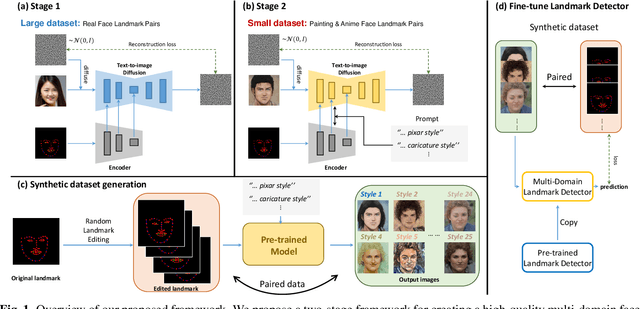
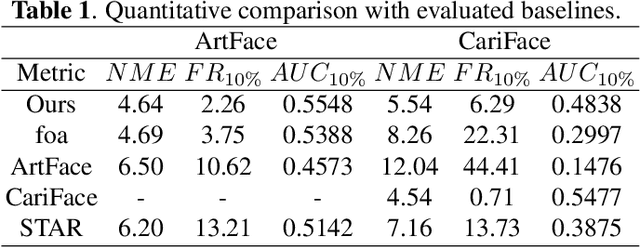
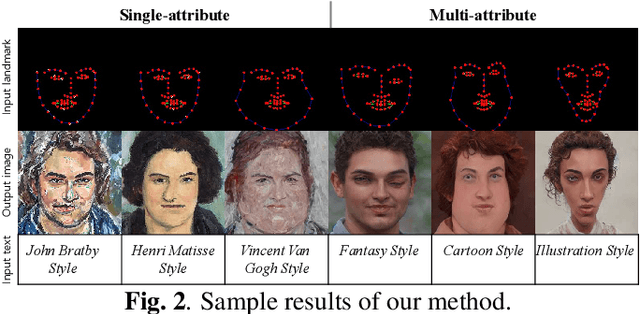
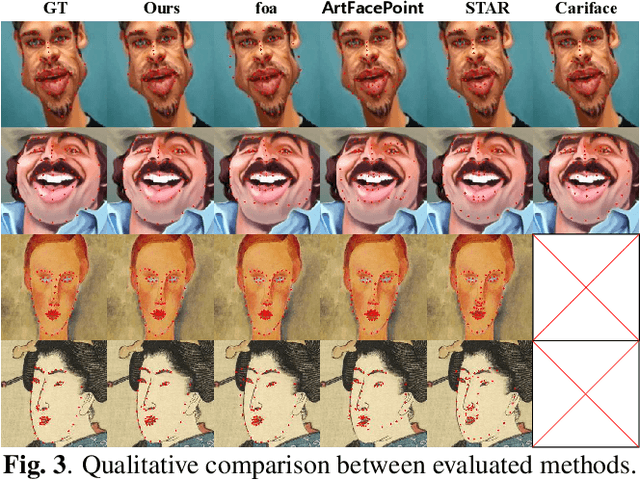
Abstract:Recently, deep learning-based facial landmark detection for in-the-wild faces has achieved significant improvement. However, there are still challenges in face landmark detection in other domains (e.g. cartoon, caricature, etc). This is due to the scarcity of extensively annotated training data. To tackle this concern, we design a two-stage training approach that effectively leverages limited datasets and the pre-trained diffusion model to obtain aligned pairs of landmarks and face in multiple domains. In the first stage, we train a landmark-conditioned face generation model on a large dataset of real faces. In the second stage, we fine-tune the above model on a small dataset of image-landmark pairs with text prompts for controlling the domain. Our new designs enable our method to generate high-quality synthetic paired datasets from multiple domains while preserving the alignment between landmarks and facial features. Finally, we fine-tuned a pre-trained face landmark detection model on the synthetic dataset to achieve multi-domain face landmark detection. Our qualitative and quantitative results demonstrate that our method outperforms existing methods on multi-domain face landmark detection.
DataCI: A Platform for Data-Centric AI on Streaming Data
Jul 03, 2023



Abstract:We introduce DataCI, a comprehensive open-source platform designed specifically for data-centric AI in dynamic streaming data settings. DataCI provides 1) an infrastructure with rich APIs for seamless streaming dataset management, data-centric pipeline development and evaluation on streaming scenarios, 2) an carefully designed versioning control function to track the pipeline lineage, and 3) an intuitive graphical interface for a better interactive user experience. Preliminary studies and demonstrations attest to the easy-to-use and effectiveness of DataCI, highlighting its potential to revolutionize the practice of data-centric AI in streaming data contexts.
DIFAI: Diverse Facial Inpainting using StyleGAN Inversion
Jan 20, 2023Abstract:Image inpainting is an old problem in computer vision that restores occluded regions and completes damaged images. In the case of facial image inpainting, most of the methods generate only one result for each masked image, even though there are other reasonable possibilities. To prevent any potential biases and unnatural constraints stemming from generating only one image, we propose a novel framework for diverse facial inpainting exploiting the embedding space of StyleGAN. Our framework employs pSp encoder and SeFa algorithm to identify semantic components of the StyleGAN embeddings and feed them into our proposed SPARN decoder that adopts region normalization for plausible inpainting. We demonstrate that our proposed method outperforms several state-of-the-art methods.
Reference Guided Image Inpainting using Facial Attributes
Jan 19, 2023



Abstract:Image inpainting is a technique of completing missing pixels such as occluded region restoration, distracting objects removal, and facial completion. Among these inpainting tasks, facial completion algorithm performs face inpainting according to the user direction. Existing approaches require delicate and well controlled input by the user, thus it is difficult for an average user to provide the guidance sufficiently accurate for the algorithm to generate desired results. To overcome this limitation, we propose an alternative user-guided inpainting architecture that manipulates facial attributes using a single reference image as the guide. Our end-to-end model consists of attribute extractors for accurate reference image attribute transfer and an inpainting model to map the attributes realistically and accurately to generated images. We customize MS-SSIM loss and learnable bidirectional attention maps in which importance structures remain intact even with irregular shaped masks. Based on our evaluation using the publicly available dataset CelebA-HQ, we demonstrate that the proposed method delivers superior performance compared to some state-of-the-art methods specialized in inpainting tasks.
MIGPerf: A Comprehensive Benchmark for Deep Learning Training and Inference Workloads on Multi-Instance GPUs
Jan 01, 2023Abstract:New architecture GPUs like A100 are now equipped with multi-instance GPU (MIG) technology, which allows the GPU to be partitioned into multiple small, isolated instances. This technology provides more flexibility for users to support both deep learning training and inference workloads, but efficiently utilizing it can still be challenging. The vision of this paper is to provide a more comprehensive and practical benchmark study for MIG in order to eliminate the need for tedious manual benchmarking and tuning efforts. To achieve this vision, the paper presents MIGPerf, an open-source tool that streamlines the benchmark study for MIG. Using MIGPerf, the authors conduct a series of experiments, including deep learning training and inference characterization on MIG, GPU sharing characterization, and framework compatibility with MIG. The results of these experiments provide new insights and guidance for users to effectively employ MIG, and lay the foundation for further research on the orchestration of hybrid training and inference workloads on MIGs. The code and results are released on https://github.com/MLSysOps/MIGProfiler. This work is still in progress and more results will be published soon.
Controllable Face Manipulation and UV Map Generation by Self-supervised Learning
Sep 24, 2022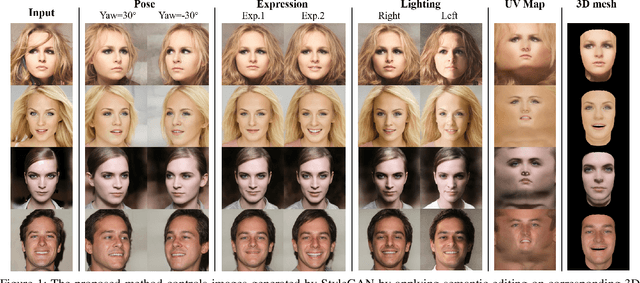

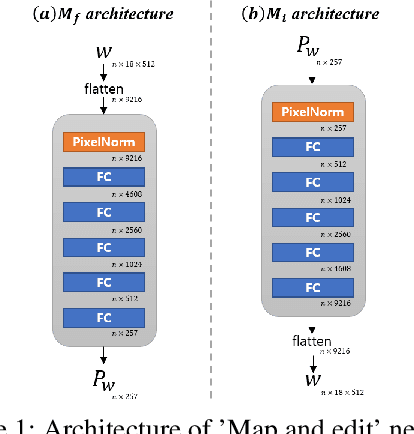
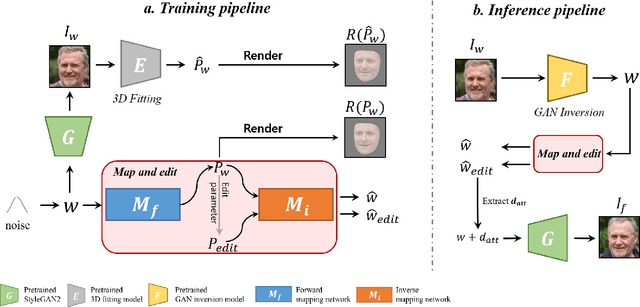
Abstract:Although manipulating facial attributes by Generative Adversarial Networks (GANs) has been remarkably successful recently, there are still some challenges in explicit control of features such as pose, expression, lighting, etc. Recent methods achieve explicit control over 2D images by combining 2D generative model and 3DMM. However, due to the lack of realism and clarity in texture reconstruction by 3DMM, there is a domain gap between the synthetic image and the rendered image of 3DMM. Since rendered 3DMM images contain facial region only without the background, directly computing the loss between these two domains is not ideal and the resultant trained model will be biased. In this study, we propose to explicitly edit the latent space of the pretrained StyleGAN by controlling the parameters of the 3DMM. To address the domain gap problem, we propose a noval network called 'Map and edit' and a simple but effective attribute editing method to avoid direct loss computation between rendered and synthesized images. Furthermore, since our model can accurately generate multi-view face images while the identity remains unchanged. As a by-product, combined with visibility masks, our proposed model can also generate texture-rich and high-resolution UV facial textures. Our model relies on pretrained StyleGAN, and the proposed model is trained in a self-supervised manner without any manual annotations or datasets.
Injecting 3D Perception of Controllable NeRF-GAN into StyleGAN for Editable Portrait Image Synthesis
Jul 26, 2022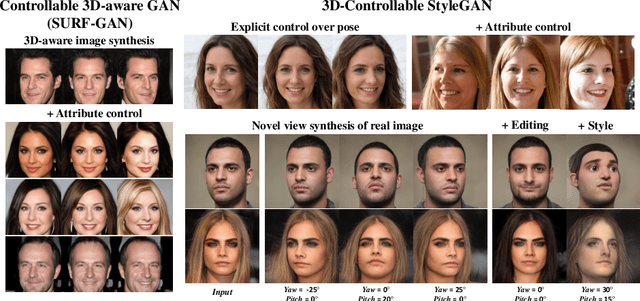

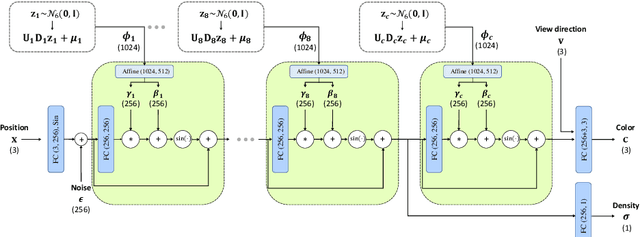

Abstract:Over the years, 2D GANs have achieved great successes in photorealistic portrait generation. However, they lack 3D understanding in the generation process, thus they suffer from multi-view inconsistency problem. To alleviate the issue, many 3D-aware GANs have been proposed and shown notable results, but 3D GANs struggle with editing semantic attributes. The controllability and interpretability of 3D GANs have not been much explored. In this work, we propose two solutions to overcome these weaknesses of 2D GANs and 3D-aware GANs. We first introduce a novel 3D-aware GAN, SURF-GAN, which is capable of discovering semantic attributes during training and controlling them in an unsupervised manner. After that, we inject the prior of SURF-GAN into StyleGAN to obtain a high-fidelity 3D-controllable generator. Unlike existing latent-based methods allowing implicit pose control, the proposed 3D-controllable StyleGAN enables explicit pose control over portrait generation. This distillation allows direct compatibility between 3D control and many StyleGAN-based techniques (e.g., inversion and stylization), and also brings an advantage in terms of computational resources. Our codes are available at https://github.com/jgkwak95/SURF-GAN.
Active-Learning-as-a-Service: An Efficient MLOps System for Data-Centric AI
Jul 19, 2022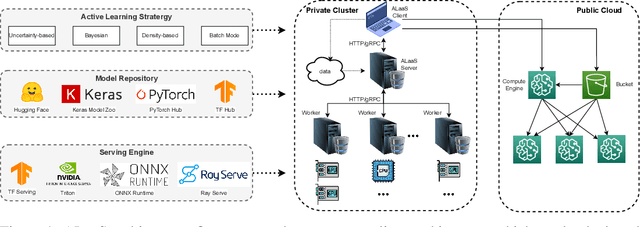

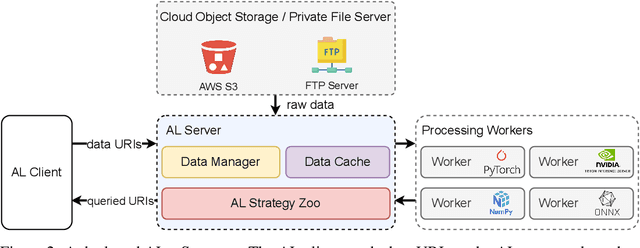

Abstract:The success of today's AI applications requires not only model training (Model-centric) but also data engineering (Data-centric). In data-centric AI, active learning (AL) plays a vital role, but current AL tools can not perform AL tasks efficiently. To this end, this paper presents an efficient MLOps system for AL, named ALaaS (Active-Learning-as-a-Service). Specifically, ALaaS adopts a server-client architecture to support an AL pipeline and implements stage-level parallelism for high efficiency. Meanwhile, caching and batching techniques are employed to further accelerate the AL process. In addition to efficiency, ALaaS ensures accessibility with the help of the design philosophy of configuration-as-a-service. It also abstracts an AL process to several components and provides rich APIs for advanced users to extend the system to new scenarios. Extensive experiments show that ALaaS outperforms all other baselines in terms of latency and throughput. Further ablation studies demonstrate the effectiveness of our design as well as ALaaS's ease to use. Our code is available at \url{https://github.com/MLSysOps/alaas}.
Generate and Edit Your Own Character in a Canonical View
May 06, 2022

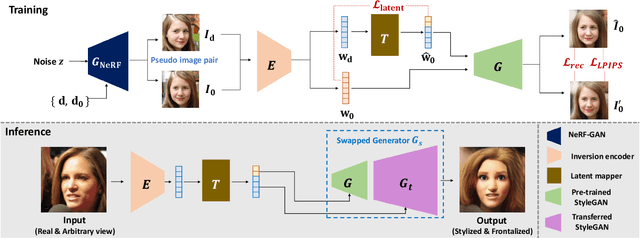
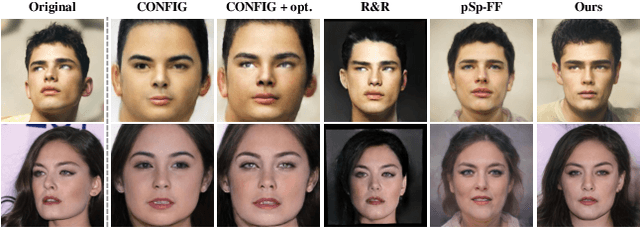
Abstract:Recently, synthesizing personalized characters from a single user-given portrait has received remarkable attention as a drastic popularization of social media and the metaverse. The input image is not always in frontal view, thus it is important to acquire or predict canonical view for 3D modeling or other applications. Although the progress of generative models enables the stylization of a portrait, obtaining the stylized image in canonical view is still a challenging task. There have been several studies on face frontalization but their performance significantly decreases when input is not in the real image domain, e.g., cartoon or painting. Stylizing after frontalization also results in degenerated output. In this paper, we propose a novel and unified framework which generates stylized portraits in canonical view. With a proposed latent mapper, we analyze and discover frontalization mapping in a latent space of StyleGAN to stylize and frontalize at once. In addition, our model can be trained with unlabelled 2D image sets, without any 3D supervision. The effectiveness of our method is demonstrated by experimental results.
 Add to Chrome
Add to Chrome Add to Firefox
Add to Firefox Add to Edge
Add to Edge